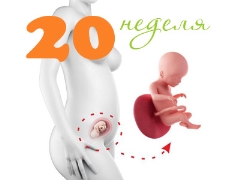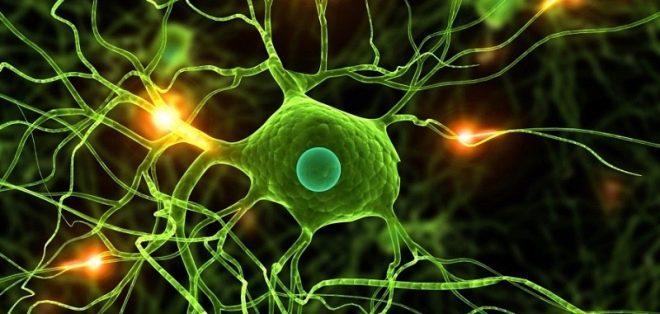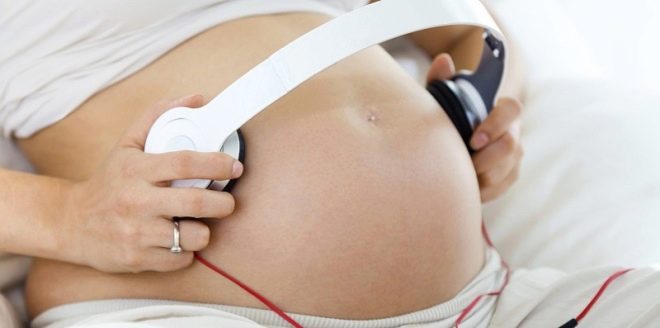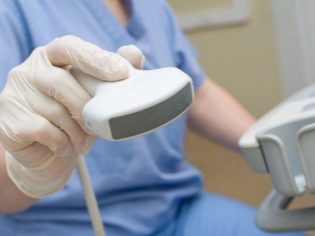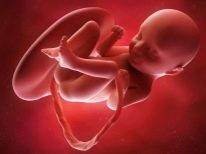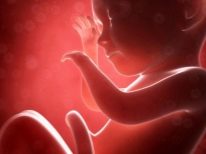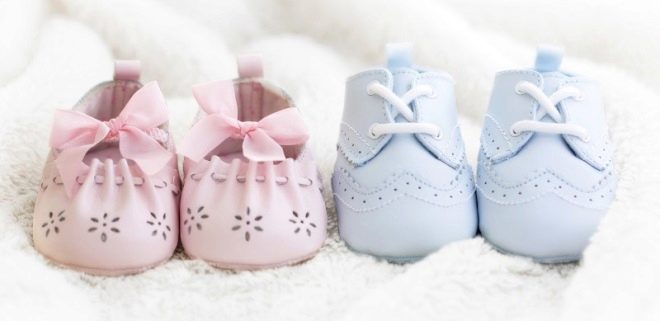Fetal development in the 20th week of pregnancy
During the 20th week of pregnancy, many interesting metamorphosis occurs in the fetus.
How does the fetus change?
20 week of pregnancy is the real high middle of the second trimester. At this time, many of the internal organs of the baby have already formed, while others continue their development and differentiation.
Heart and vessels
The cardiovascular system plays a very important role in the children's body. It is thanks to the pumping function of the heart that blood is delivered to all internal organs with nutrients and oxygen dissolved in it. Without a full heart activity, a good intrauterine development of the baby should not be expected. The heart of the fetus to 19-20 weeks already formed. Moreover, it can pump about 29 liters of blood per day. This is necessary so that all intensively growing internal organs of the baby receive enough nutrients.
Fetal heartbeat is the most important clinical sign followed by every obstetrician. The frequency of heart contractions or heart rate is very important information for a specialist. It shows how comfortable the fetus is in the womb.
If the fetus's heartbeat exceeds certain norms, then the doctors state the presence of tachycardia. Excessively low beat is called bradycardia.
The heart rate is shown in the table below:
Fetal heart rate | Heart rate in the 20th week of pregnancy |
Heart rate | 140-160 beats per minute |
Every day the number of blood vessels in the baby increases. This process is necessary due to the growing need of the child's body to provide the internal organs with various nutrients. Strengthens the vascular wall. Gradually increases the diameter of the veins and arteries.
Nerves and the brain
Interesting changes begin to occur in the main "computer" of the body. Between neurons, special brain cells, more and more contacts appear every day. Such a complex interneuronal network provides the complexity of the baby's behavior. Every day the behavior of the fetus changes.
The brain in the body performs the basic coordinating function. To follow the development of this organ in the children's body is very important. That is why during the ultrasound in the 20th week of pregnancy, specialists must evaluate the main structures of the brain. In conducting this survey, they can assess the development of the main parts of the cerebral cortex, as well as identify cysts and other defects.
Cysts in their localization may be different. They can be in the choroid plexus or in the brain tissue itself. Unfortunately, quite a few such pathologies are currently registered.
When a brain cyst is detected at this stage of pregnancy, it is very important to consult your doctor about this.
Digestive organs
Most of the internal organs that are involved in the process of digestion and the production of food, have already formed. Some of them are even starting to work. So, the baby has bile. In its chemical composition, it is certainly different from the bile of an adult, but performs a very important function. Thanks to bile, the formation of original feces.
The digestive organs of a baby have certain dimensions that can already be determined by ultrasound. Thus, by performing an ultrasound examination, a specialist can determine the hyperechoic intestine, the size of the liver, and other clinical parameters.
It is important to note that the baby’s full digestion process will begin only after it is born. The first portion of breast milk will “launch” the work of the entire digestive system. At week 20, only serious preparation of the digestive organs for their future work takes place.
First sensations
Neural analyzers are important tools in the process of exploring the world. At the 20th week of pregnancy, the baby is already preparing for further independent living. By the time of birth, all its organs and systems should already be formed and be ready to perform their functions.
A child is able to hear the voices of his parents. Scientists note that the mother’s voice has a calming effect on the fetus. It is not only possible, but necessary, to talk with this child at this time. Such “conversations” will contribute to the formation of a positive psycho-emotional connection between mother and baby. Some scientists believe that week 19-20 is a great time to begin to form a musical ear for a baby.
This time is great for listening to classical music. Of course, the kid will not remember them and will not be able to fully appreciate them, but classical music will have a beneficial effect on his nervous system. It is better to choose quieter and more melodic music, in which there are no excessively loud sounds.
By the 20th week of pregnancy, the child already has the ability to distinguish between different tastes. He does this by "trying" the amniotic fluid. In fact, swallowing a small amount of amniotic fluid is necessary for the baby to fully form its urinary system. Amniotic fluid is a very important part of intrauterine life. All growth and development from the moment of conception to direct birth occurs in a special aquatic environment. That is why it is very important to evaluate the amniotic fluid during an ultrasound scan. Specialists during the survey can determine the amount of amniotic fluid, as well as to identify the presence of any inclusions or suspensions.
The baby at 20 weeks of his intrauterine life can already urinate. This contributes to the regular updating of the chemical composition of the amniotic fluid. To worry about the fact that the child may choke is not worth it. This process is conceived by nature and is one of the most important stages of fetal development.
The first active movements of the baby
By this period of its prenatal life, the fetus should already have a fairly well-formed musculoskeletal system. Intensive development of bones and muscles had occurred in the preceding weeks of pregnancy.
The fetus is already quite developed limbs. The spine continues to develop. So, in his cervical mobility significantly increased. This contributes to the fact that the baby is able to make a lot of head movements. The developed muscular system of the child helps him to move. It often happens that the future mother sees the first movements of her baby at 20-22 weeks of pregnancy. Such tremors in the stomach cause a lot of joy in a pregnant woman and make her understand that very soon she will become a mother.
It is important to note that the movement activity of the baby may be different. It depends on a huge variety of factors.For example, if the baby is small and the amount of amniotic fluid is quite large, then the fetal physical activity will not be intense. Calm kids can move a little less than restless. With each further week of pregnancy, fetal locomotor activity is an increasingly important indicator of the progress of its intrauterine development.
If the baby pushes too intensively during the day, then this may be due to a certain discomfort that the fetus experiences in the womb. Too turbulent physical activity of the fetus - a reason to consult with your doctor.
Body parameters
Fetal sizing is a very important marker of the intensity of its intrauterine development. Every day, the child gains weight. By this period of pregnancy, it already weighs much more than in the first weeks after conception. The height and weight of the baby at the 20th week of his intrauterine life are presented in the table below:
Clinical sign of the fetus | Norm |
Growth | 25-30 cm |
Body mass | 250-450 g |
Determination of the basic parameters of the body of the fetus is carried out using fetometrii. This ultrasound method will allow doctors to assess what size the fetus has in a certain period of its prenatal development. Assigns conducting fetometri obstetrician-gynecologist, who oversees the course of a specific pregnancy. During the ultrasound examination is very interesting to observe the behavior of the baby.
The child at this time can move the arms or legs, smile, or simply turn away from the sensor examining it. A calm child may look like he is just sleeping.
Fetal location
Determining the position of the baby in the uterus is very important. The more the child becomes and the closer the birth, the more important its location. In the 20th week of pregnancy, the position of the fetus in the uterus is, as a rule, unstable. By birth, the baby can roll over several more times.
The most physiologically beneficial doctors believe headache. In this case, the head of the child is directed towards the entrance to the small pelvis. This presentation is very favorable, as it contributes to the easy flow of labor. When the head previa baby head will move first. In this case, the further "birth" of the child's body will already be much easier.
Less favorable - breech presentation. In this case, the baby is in the uterus as if “the other way round”: with its pelvic end it is facing towards the entrance to the small pelvis. With this arrangement, the normal physiological course of labor is usually difficult. In this situation, the risk of birth damage during independent natural childbirth increases many times. As a rule, in this case, doctors resort to the surgical method of obstetric aid - cesarean section.
There are also other options for the position of the fetus in the uterus. Baby have a transverse or low position. In this case, the development of certain pathologies is possible, the development of which must be followed by the doctors.
Pathological variant of the location of the baby can be dangerous leakage of amniotic fluid. The appearance of this unfavorable symptom should be the reason for an urgent appeal to a doctor.
Appearance
Baby looks very funny. He already reminds some of his features of an adult, but in miniature. In a child, the proportions of the body change significantly. His head no longer seems so huge relative to the body. Hands and legs are extended. In a child, the feet and palms are already well defined, on which small fingers can be distinguished. Each of them has its own unique skin pattern, forming an imprint. The baby is already well distinguished little nose, forehead, cheeks. Eyes outside cover their eyelids. Small eyebrows grow above the eye slits. The fetus even has short cilia.
Almost all his body is covered with downy hair. Their structure is rather thin.Outside, the skin is covered with a special original lubricant. It is formed by mixing the secret of sweat and sebaceous glands, which are already functioning in a baby, with desquamated epithelium. The color of the original lubricant, usually whitish with a slight yellowish tinge. It will remain on the skin of the child until the very birth.
Is it possible to determine the sex of the child?
Future parents usually can not wait to find out who they will be born: a boy or a girl. At week 20 it's pretty easy to figure out. The reproductive system of the fetus by this time of pregnancy is almost completely formed. This leads to the possibility of establishing the floor when conducting ultrasound. With multiple pregnancies, the sex of each of the babies is determined.
Note that when determining the sex of a child, an ultrasound specialist may make a mistake. This mainly occurs in the case of insufficient competence of the doctor or during the examination on old ultrasound equipment. You can recheck the result a little later - during the next ultrasound.
How the fetus develops in the 20th week of pregnancy, see the next video.
